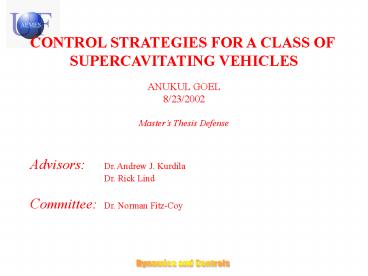CONTROL STRATEGIES FOR A CLASS OF - PowerPoint PPT Presentation
1 / 23
Title:
CONTROL STRATEGIES FOR A CLASS OF
Description:
Navy needs next generation torpedoes and high speed underwater ... No Phugoid mode (Similar to F-16 aircraft) EOM: Aircraft = Supercavitating Torpedo ... – PowerPoint PPT presentation
Number of Views:112
Avg rating:3.0/5.0
Title: CONTROL STRATEGIES FOR A CLASS OF
1
CONTROL STRATEGIES FOR A CLASS OF
SUPERCAVITATING VEHICLES ANUKUL
GOEL 8/23/2002 Masters Thesis Defense
Advisors Dr. Andrew J. Kurdila
Dr. Rick Lind Committee Dr. Norman Fitz-Coy
2
OUTLINE
- Introduction and Motivation
- Equations of Motion
- Control Objectives
- LQR Control Synthesis
- Nonlinear Simulation
- Conclusion
3
INTRODUCTION
- Motivation
- Navy needs next generation torpedoes and high
speed underwater - vehicles such as SUPERCAVITATING VEHICLES
- Limited research available in public domain for
modeling and - control of supercavitating vehicles.
- This project was to model and control and
prototypical - supercavitating torpedo.
- My contributions to the project
- Equation of motion (Anand and Anukul)
- Linear equations of motion (Anand and Anukul)
- Control Synthesis (Anukul)
- Nonlinear Simulations (Anukul)
4
CAVITATION
- At High Velocity
- Fluid Velocity Increases
- Fluid Pressure Drops below
- Vapor Pressure
- Fluid Vaporizes
Tip Vortex Cavitation
Supercavitation
5
ISSUES WITH SUPERCAVITATION
Advantages
Disadvantages
- High Frequency Motions
- Prediction of Cavity
- Control and Maneuvering
- Maintaining the Cavity
- Low Skin Friction Drag
- High Velocities
6
VEHICLE MODEL CONTROL SURFACES
Lc
Le1
De1
Dc
W
Cavitator
- 2 Elevators
- 2 Rudders
- 1 Cavitator
1 DOF Fin
1 DOF Cavitator
7
CAVITATOR/FIN MODEL
Cl for Cavitator
Half angle 150
Cl for Fin
Angle of attack (deg)
Sweepback angle0 deg
Angle of attack (deg)
8
EQUATIONS OF MOTION NONLINEAR
- Equations of motion are identical for torpedo
and aircraft.
- Consider force equation
- Additional 9 equations for moment, orientation
and position.
- Components of forces and moments are unique for
torpedo.
- Consider force in body fixed X-axis direction.
- Similar decomposition for all forces and moments.
9
EQUATIONS OF MOTION LINEAR
10
OPEN-LOOP DYNAMICS
- Consider root locus of open-loop poles for
linearizing airspeed
- Open-loop system is always unstable
- No Phugoid mode (Similar to F-16 aircraft)
11
CONTROL OBJECTIVE
- Track a pitch or roll rate command up to 30
deg/s - and
- maintain an overshoot less than 15.
- have rise time less 0.5s.
- have a steady-state error less than 5.
- Avoid actuator saturation
Control Surface Limits
12
ASSUMPTIONS FOR CONTROL SYNTHESIS
- The cavity model is fixed cavity. Thus there is
no variation of immersion - and the torpedo is symmetrically situated in
the cavity. - Longitudinal controls are cavitator and
horizontal fins only - Lateral controls are 2 vertical fins (rudders).
- It is assumed that 9 states (velocities, angular
rates and orientation ) are - available for feedback for tracking
controller. - It is assumed that control surface deflection of
small order (0.1 deg for - longitudinal and 0.01 for lateral) are
achievable. - Propulsive force is assumed to be constant during
flight, the constant value - being obtained during trim optimization.
13
LQR SYNTHESIS
- Find Controller K such that u-Kx minimizes
- x is the state
- u is the control from K
- Q and R are weighting matrices
- In case of longitudinal feedback 4 states and
tracking error
- In case of lateral feedback 5 states and
tracking error
14
LQR LONGITUDINAL
- More weighting on cavitator to ensure more use
of elevator - Weighting of zero on all states to allow for
their variation
Cavitator Deflection
Linear Response
Cavitator (deg)
q (deg/s)
Time (s)
Time (s)
15
LQR LATERAL
Linear Response
Rudder Deflection
Rudder (deg)
Roll rate (deg/s)
Time (s)
Time (s)
16
NONLINEAR SIMULATION
de1 (deg)
- Command 15 deg/s doublet
- of pitch rate
de1 rate (deg/s)
- Rise Time 0.17s
- Overshoot 11.53
- Minimal lateral response
- Unstable for commands gt 30 deg/s
Time (s)
17
NONLINEAR SIMULATION
dr1 (deg)
p (deg/s)
Time (s)
- Command 15 deg/s doublet
- of roll rate
q (deg/s)
- Rise Time 0.5s
- Overshoot 0
- Coupled motion
- Unstable for commandsgt50 deg/s
Time (s)
18
ROBUSTNESS GAIN/PHASE MARGINS
x
19
ROBUSTNESS GAIN/PHASE MARGINS
Longitudinal (Inner and Outer loop) Gain Margin
inf Phase Margin 57deg
Magnitude (dB)
Phase(deg)
Frequency (rad/sec)
Magnitude (dB)
Lateral (Inner and Outer loop) Gain Margin
50.36 dB Phase Margin inf
Phase(deg)
Frequency (rad/sec)
20
ROBUSTNESSPERTURBED RESPONSE
- 20 Perturbation given in values of cl, cd,
immersion. - Small variation in A, B matrices.
- Stable eigenvalues remain stable for variation
with velocity. - Closed-loop response was acceptable with nominal
controller.
- Tracking objectives are met
- Small variations in airspeed
21
- 10 uncertainty in coefficients of lift and drag
of cavitator - introduced into system during synthesis.
- Good Lateral performance obtained.
- Good Longitudinal controller not obtained
possibly as the - controller tries to stabilize the uncertain
poles.
22
- Higher overshoot and
- rise time.
- Saturation for commands
- higher than 20 deg/s.
p (deg/s)
Time (s)
- Rise time 0.025s
- Overshoot 0
- Saturation for commands
- higher than 40deg/s
p (deg/s)
Time (s)
23
CONCLUSIONS
- A model for supercavitating torpedo has been
achieved - A LQR controller has been obtained than gives
good - performance for pitch and roll rate
tracking. - A controller for lateral dynamics has been
obtained - that shows good performance.
- The controller for longitudinal is yet to be
obtained. - The model for cavity is assumed to be fixed.
Dynamic - model for cavity is yet to be obtained.
- The Pitch and Roll rate controllers are for
inner-loop - model. An outer-loop controller can be
obtained for - guidance and navigation
FUTURE WORK































